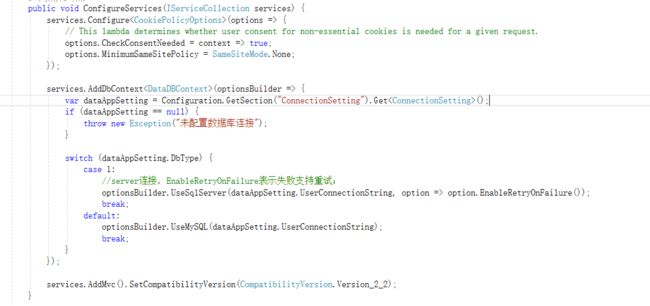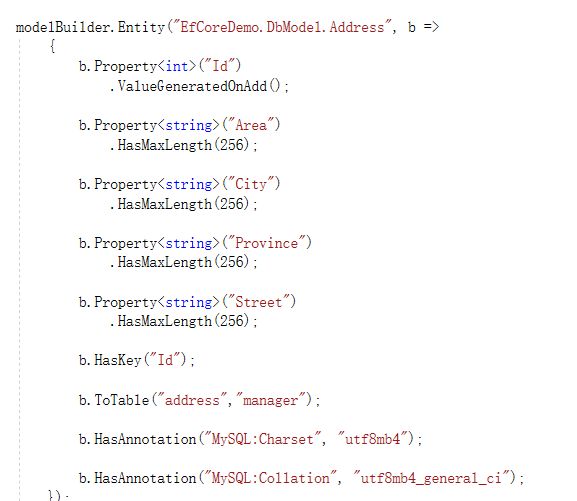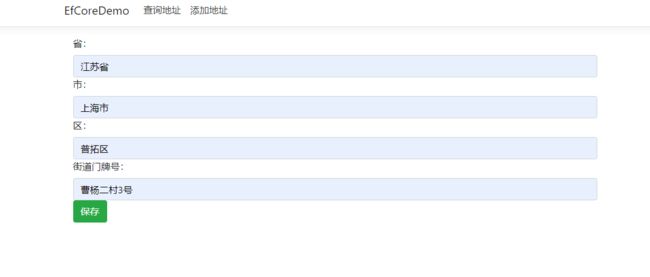netcore使用EFcore(第一个实例)
说明:搭建netcore 使用efcore入门教程,跟着这个教程,傻瓜都可以成功!O(∩_∩)O哈哈~,咱们开始吧;
首先介绍下环境:
vs2017,
netcore2.2,
EntityFramework6
测试场景:Mysql,SqlServer
一、创建netcore模板项目
这个就不用多说了,创建完成看下版本:
二、引用EF Core
有的博主写的这样引用:Install-Package Microsoft.EntityFrameworkCore.Sqlite –Pre
但是,遗憾的是,报错了:
然后我自己引用了以包,OK
为了方便复制,我直接复制出来:
1.Microsoft.EntityFrameworkCore
2.Install-Package Microsoft.EntityFrameworkCore.Sqlite
3.Install-Package Microsoft.EntityFrameworkCore.Design
4.Install-Package Microsoft.EntityFrameworkCore.Tools
项目结构如下:
三、创新测试的实体类
我这边创建了一个DBModel文件夹,然后分别创建了三个类:
OrderInfo.cs,
Passenger.cs,
Address.cs
为什么要创建这么几个呢:因为后续会设计到表之间关联关系,主键,外键,引用等等,当然,本文主要是入门,后面的文章会详细讲解;
(PS:关系:一个OrderInfo有一个Passenger和一个Address,一个Passenger又可以有多个OrderInfo和一个Address);
强调:需要引用MySql.Data.EntityFrameworkCore
OrderInfo.cs
![]()
[MySqlCharset("utf8mb4")] //字符集,需要引用MySql.Data.EntityFrameworkCore
[MySqlCollation("utf8mb4_general_ci")] //排序规则
[Table("orderinfo", Schema = "manager")]
public class OrderInfo {
[JsonProperty("id")]
[Required]
[Column("id", TypeName = "int(11)")]
public int Id { get; set; }
///
/// 订单Id
///
[JsonProperty("order_id")]
[Required]
[Column("order_id", TypeName = "int(11)")]
public int OrderId { get; set; }
[JsonProperty("passengerid")]
[Column("passenger_id",TypeName ="int(11)")]
public int PassengerId { get; set; }
[JsonProperty("addressid")]
[Column("address_id", TypeName = "int(11)")]
public int AddressId { get; set; }
///
/// 订单价格
///
[StringLength(maximumLength: 100)]
[Column("price")]
public string Price { get; set; }
///
/// 订单客人信息
///
[ForeignKey("PassengerId")]
public Passenger OrderForPassenger { get; set; }
/
/ 订单地址信息
/
//[InverseProperty("OrderInfos")]
//public Address OrderForAddress { get; set; }
![]()
Passenger.cs
![]()
[MySqlCharset("utf8mb4")] //字符集,需要引用MySql.Data.EntityFrameworkCore
[MySqlCollation("utf8mb4_general_ci")] //排序规则
[Table("passenger", Schema = "manager")]
public class Passenger {
[JsonProperty("id")]
[Column("id", TypeName = "int(10)")]
public int Id { get; set; }
[JsonProperty("passenger_id")]
[Column("passengerid",TypeName ="int(11)")]
public int PassengerId { get; set; }
[JsonProperty("passengername")]
public string PassengerName { get; set; }
[InverseProperty("OrderForPassenger")]
public List OrderInfos { get; set; }
//[InverseProperty("Passengers")]
//public Address PssengerForAddress { get; set; }
}
![]()
Address.cs
![]()
[MySqlCharset("utf8mb4")] //字符集,需要引用MySql.Data.EntityFrameworkCore
[MySqlCollation("utf8mb4_general_ci")] //排序规则
[Table("address", Schema = "manager")]
public class Address {
[JsonProperty("id")]
[Required]
public int Id { get; set; }
[JsonProperty("province")]
[StringLength(maximumLength: 256)]
public string Province { get; set; }
[JsonProperty("city")]
[StringLength(maximumLength: 256)]
public string City { get; set; }
[JsonProperty("area")]
[StringLength(maximumLength: 256)]
public string Area { get; set; }
[JsonProperty("street")]
[StringLength(maximumLength:256)]
public string Street { get; set; }
}
![]()
四、创建一个DataDBContext.cs类,代码如下
| 1 2 3 4 5 6 7 8 9 10 11 12 13 14 15 16 17 18 19 |
|
五、创建数据库初始化和连接
为了方便测试,将数据库连接配置放在了appsettings.json文件中了。配置文件内容如下:
![]()
{
"Logging": {
"LogLevel": {
"Default": "Warning"
}
},
"AllowedHosts": "*",
"ConnectionSetting": {
"UserConnectionString": "server=localhost;userid=root;pwd=123456;port=3306;database=manager",
"ReadConnectionString": "server=localhost;userid=root;pwd=123456;port=3306;database=manager",
"DbType": 0 //数据库类型
}
}
![]()
在StartUp.cs中注册连接:
![]()
services.AddDbContext(optionsBuilder => { var dataAppSetting = Configuration.GetSection("ConnectionSetting").Get (); if (dataAppSetting == null) { throw new Exception("未配置数据库连接"); } switch (dataAppSetting.DbType) { case 1: //server连接,EnableRetryOnFailure表示失败支持重试; optionsBuilder.UseSqlServer(dataAppSetting.UserConnectionString, option => option.EnableRetryOnFailure()); break; default: optionsBuilder.UseMySQL(dataAppSetting.UserConnectionString); break; } });
![]()
这里可能有朋友会问一下,万一数据库没有创建怎么办?
所以,这里Configure方法加一下内容
context.Database.EnsureCreated();//数据库不存在的话,会自动创建
六、打开对应文件目录,执行
打开文件夹的命令行,
输入
dotnet ef migrations add MyFirstMigration
dotnet ef database update
这样我们就创建好了数据库。更多命令请 dotnet ef -h
可以看到,里面其实是执行了创建数据库表的sql语句!
那我,我们来看一下我数据库,结果如下:
有的朋友可能会问,为啥多了一个表:“_efmigrationshistory”,故名思义,这个表示执行操作的记录,因为可能对表增加字段,修改字段,删除字段等等;
当然只是一个记录:
运行完成之后,我们会发现,我们会多一个Migrations文件夹
里面的内容是什么呢,大家可以打开看看,下面是我的部分截图:
可以看到,这些都是我们之前创建实体时的一些属性,如果是第一次尝试的朋友也没有必要设置这么多。
七、测试效果
简单写了个demo测试效果
话不多说,直接上代码:
Index.cshtml
![]()
@model IEnumerable@{ ViewBag.Title = "地址"; }
@foreach (var item in Model) { Id 省 市 区 街道详细地址 } @Html.DisplayFor(modelItem => item.Id) @Html.DisplayFor(modelItem => item.Province) @Html.DisplayFor(modelItem => item.City) @Html.DisplayFor(modelItem => item.Area) @Html.DisplayFor(modelItem => item.Street)
![]()
AddAddress.cshtml
![]()
@model EfCoreDemo.DbModel.Address
@{
ViewData["Title"] = "Address";
}
![]()
AddressController.cs
![]()
public class AddressController : Controller
{
private DataDBContext _context;
public AddressController(DataDBContext context) {
_context = context;
}
public IActionResult Index()
{
return View(_context.Addresses.ToList());
}
public IActionResult AddAddress() {
return View();
}
[HttpPost]
[ValidateAntiForgeryToken]
public IActionResult AddAddress(Address address) {
if (ModelState.IsValid) {
_context.Addresses.Add(address);
_context.SaveChanges();
return RedirectToAction("Index");
}
return View(address);
}
![]()
运行效果:
至此,初级版本搭建成功,且运行成功;
后记:本文主要是记录一下netcore怎么搭建efcore,只属于基础,自己学习的过程中也方便跟大家一起探讨,我们使用数据库的时候,不可能只有单独的几张表,
一般都会有主键,外键,索引,组合索引等等,
或者对表的操作,删除,修改,新增字段等等;
后续会继续更新更多的efcore的东西,如有问题,欢迎一起讨论。
感谢以下文章提供的启发:
参考博客:https://www.cnblogs.com/liangxiaofeng/p/5806347.html
参考文档:https://docs.microsoft.com/zh-cn/ef/core/get-started/netcore/new-db-sqlite













